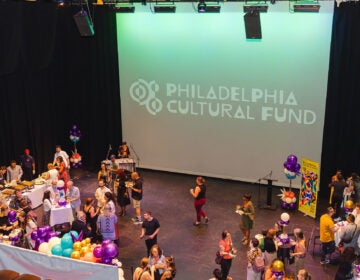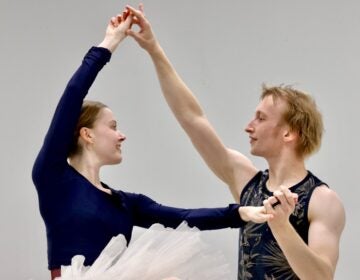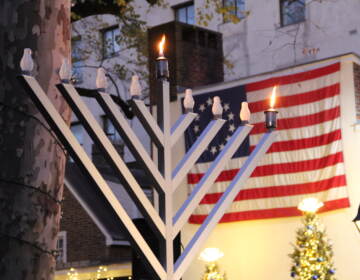Project underway to get Philadelphians to see public monuments in new way [video]
ListenA three-month experiment in public memorials begins this week in Philadelphia.
The Monument Lab will present work by 20 artists in 10 city parks, each trying out new ways to create public monuments. The public is asked to submit their own ideas and inspirations.
The project — years in the making — became exponentially more urgent because of events this summer in Charlottesville.
Most of the ten parks being used by Mural Arts Philadelphia for Monument Lab projects are clustered downtown and in its surrounding neighborhoods, where monuments will be constructed out of things like photographs, sound, discarded rowhouse stoops, trash, light, and performance – as well as more traditional medium like sculpture and paint.
Tyree Guston, famous for his Heidelberg Project in Detroit, will transform an entire building in Kensington into a monument.
The most outlying project is in Vernon Park, in Germantown. It has a sculpture commemorating the Battle of Germantown, a Revolutionary War skirmish that we — meaning the American rebels — lost.
“I appreciate that it’s a monument to something that’s failed,” said artist Karyn Olivier. “We need more things that honors things that have failed. Failure can lead to beautiful things.”
Olivier lives in this neighborhood, and walks past the statue all the time. It has been here for over a century. She made it disappear: she built a box of mirrors around it, which does a kind of magic trick. The mirrors reflect the surrounding trees, so it appears to vanish into a forest.
“I had a feeling the reflection of trees would make that happen, but I didn’t know how intensely,” said Olivier. “I’ve been working here for days, now. I was walking toward it this morning and I literally said, ‘Where is it?'”
For Olivier, monuments are problematic: they are permanent fixtures in the landscape, but erected by people who, more often than not, are no longer with us. They often outlive the ideas that caused them to exist. By obscuring a statue under a box of mirrors for three months, she hopes invigorate people’s curiosity. Maybe they will think about their personal feeling for the statue, and why it’s there in the first place.
That’s one of the central points of Monument Lab: to rethink Philadelphia’s existing inventory of public monuments, and practice new ways of making future monuments. The city has one of the largest collections of public art in the world, including about 1500 monuments to particular people. Women and African-Americans are woefully underrepresented.
“Monuments are always products of their time. Always reflections of power,” said Monument Lab artistic director Paul Farber, who also teaches history at Haverford College. “To know that many Confederate monuments went up during Jim Crow and the Civil Rights movement is a reminder of that.”
In the center of Philadelphia’s downtown, in Municipal Plaza directly across the street from City Hall, the artist Hank Willis Thomas erected a giant afro pick. The tines of the pick are embedded in the plaza’s stone, and sticking into the air is its handle shaped like a Black Power fist.
Thomas, who is based in New York City, grew up in Philadelphia until he was seven years old. When Monument Lab approached him to create a monument for Philadelphia, he dug into his childhood.
“This was a period in the late 70s when that kind of afro pick was very popular and in vogue,” he said. “It was cool to walk down the street with an afro pick with a black fist in your hair. I didn’t’ quite understand what that meant, and what it was, but it was definitely one of the first objects that was loaded for me.”
The afro pick sculpture is placed a few yards from the statue of former Mayor Frank Rizzo, which has recently come under fire by people who point to Rizzo’s history of police brutality and racism. They have raised a call to have it removed.
While a Black Power afro pick in such close proximity to Rizzo seems like a like a loaded proposition, Thomas said he was not considering Rizzo when he conceived it. Rather, he said the pick is an homage to one of his artistic heroes, Claes Oldenburg, whose giant clothespin is a block south and giant paintbrush a block north.
That the pick was erected at the same time people are calling to remove Rizzo, he said, is coincidence.
Mural Arts Philadelphia has been planning Monument Lab for years, lining up a roster of artists and location to experiment with different ways to commemorate. What it did not anticipate was a neo-Nazi rally in Charlotesville around a Confederate War memorial. It ramped up the emotion around this project.
“We’re near a wound in our culture,” said Farber. “We have tried to listen to, since the beginning of this project, that pain that already existed. The coping mechanisms, the creativity that make people stand next to monument to make their voices heard, that’s on our mind.”
In a way, the tragic rally in Charlottesville scooped Monument Lab by forcing a conversation over about the problem of memorials. It’s a conversation historians have been having for years. Over the summer it became a public talking point.
Monuments are often created at moments in history when the city or the nation is trying to deal with a difficult situation. Seth Bruggeman, a history professor at Temple University, said it’s a way of passing the buck.
“Sometimes we need to pass the buck,” he said. “Think about 9/11. Our country did not have the capacity, I think, to have a critical conversation about what that event really meant in the days after. How do we deal with that? We build a monument. That’s OK. That problem is, once we finish the monument and walk away we forget that monument represents an unresolved conversation.”
Bruggeman was standing on Philadelphia’s Independence Mall, which he said is a showcase the evolution of American monument making, from a reverent statue of George Washington, to the fabricated sanctity of the Liberty Bell, to the complex racial history of the President’s House.
There is some kind of commemoration in every direction you look, but the reason those monuments were made are nowhere to be seen.
“A monument is always concluding punctuation to the sentence,” said Bruggeman. “When you see a monument you’re seeing the end of a sentence, but you never get to know what the sentence was.”
A big component of the Monument Lab is asking for public feedback. At each site, people will be able to contribute their own ideas of what would be an appropriate monument to the City of Philadelphia. Those suggestions will be put into a database.
None of those ideas will actually be built. That’s not the point. Monument Lab’s most permanent contribution to the city’s landscape will be a dataset of unfiltered ideas gleaned from residents about what they say is worthwhile remembering in Philadelphia, right now. A report detailing the public’s reactions and inspirations about public monuments will be made available to teachers, city officials, and directors of arts organizations.
WHYY is your source for fact-based, in-depth journalism and information. As a nonprofit organization, we rely on financial support from readers like you. Please give today.





